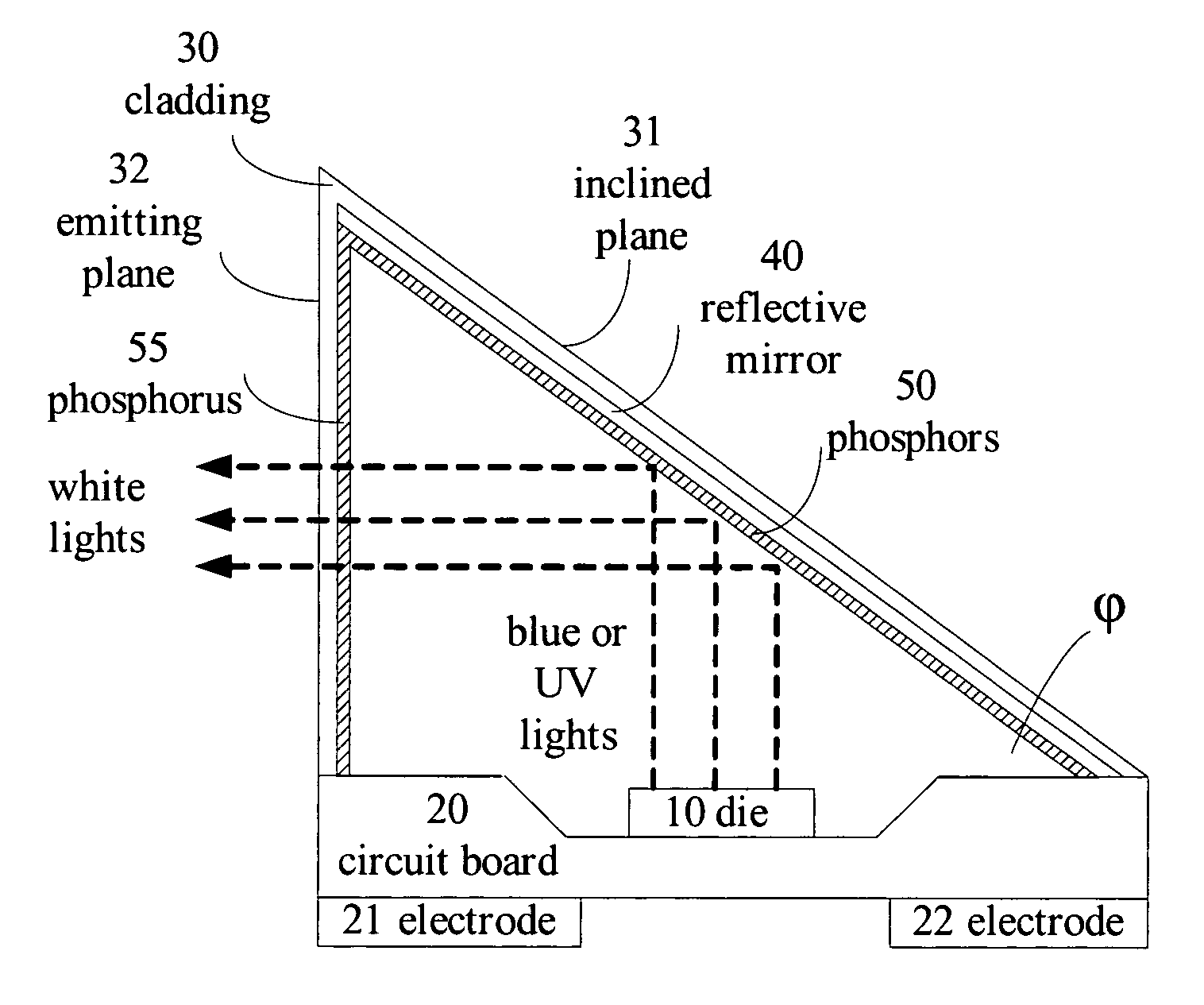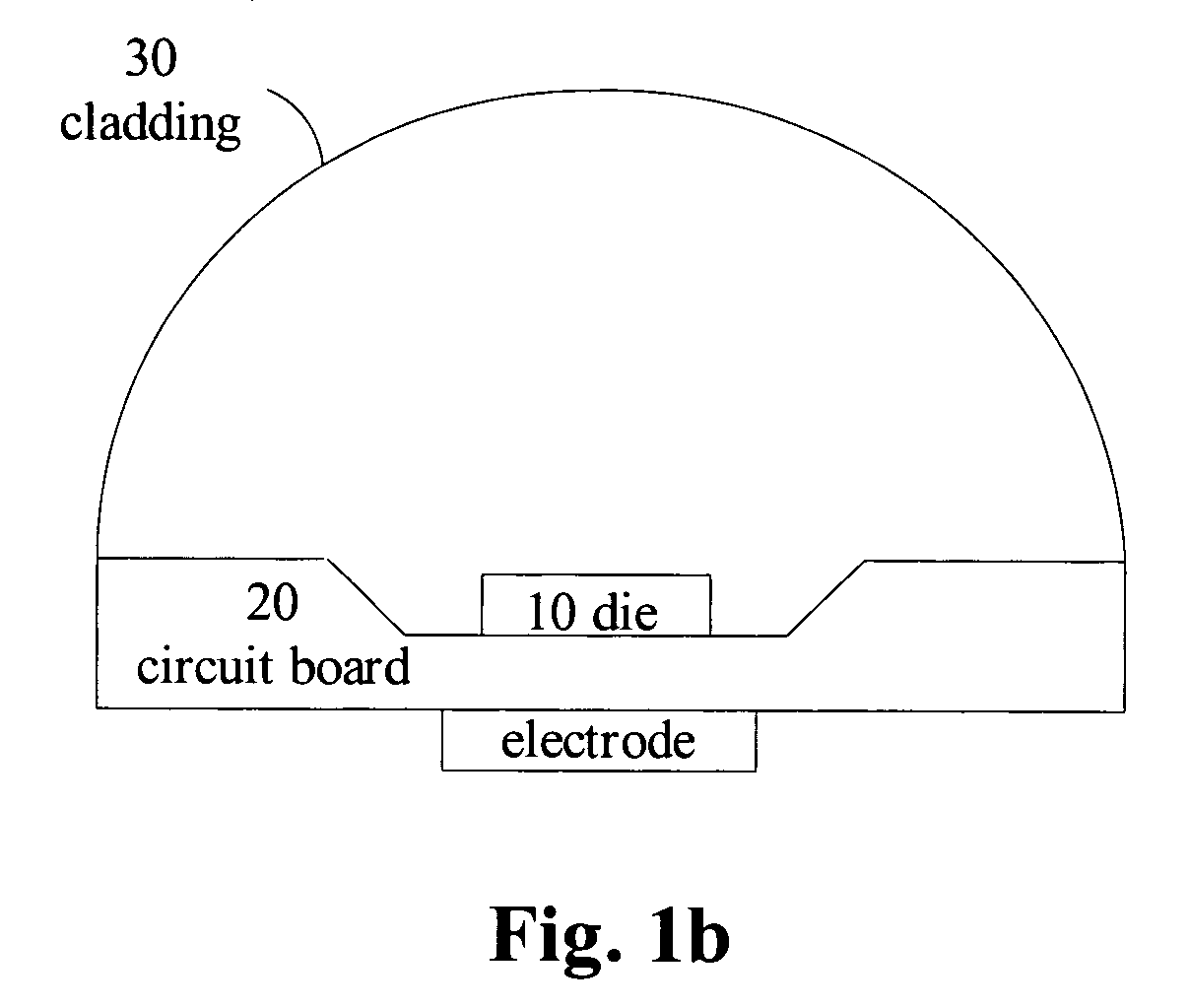White light emitting diode using phosphor excitation
a light-emitting diode and white light-emitting technology, which is applied in the direction of discharge tube/lamp details, luminescnet screen, discharge tube/lamp details, etc., can solve the problem of low color rendering index, difficulty in controlling the proportions of the participation of blue and yellow lights, and white lights usually have a non-uniform light color. achieve the effect of increasing the lifetime of white leds
- Summary
- Abstract
- Description
- Claims
- Application Information
AI Technical Summary
Benefits of technology
Problems solved by technology
Method used
Image
Examples
first embodiment
[0017]FIGS. 1a and 1b show a cross sectional side view, and a front view of the white LED according to the present invention, respectively. As shown in FIG. 1a and FIG. 1b, a conventional blue or UV LED die 10 is arranged on a circuit board 20 having a positive electrode 21 and a negative electrode 22. The LED die 10 is driven to emit blue lights or UV lights when an external voltage is applied onto the positive electrode 21 and the negative electrode 22.
[0018]A conventional LED is usually encapsulated in a transparent, cylindrical bell cladding made of epoxy to protect the LED die 10 and the circuit board 20 therein. Meanwhile, the bell cladding also provides light convergence similar to a convex lens. Instead of using a bell cladding, a cylindrical cladding 30 having an inclined plane 31 on the top, as if it is obtained from cutting a right cylinder in half at an inclined angle, is used in this embodiment. The included angle φ between the inclined plane 31 and the circuit board 20...
second embodiment
[0024]In this embodiment, a simple reflective structure in which the phosphors and the LED die are separately arranged, thereby preventing the phosphors from heat deterioration and avoiding the problem of reduced lifetime of the LED. Based on the same concept, in another embodiment, the phosphors are coated on the inner surface of the emitting plane 32, but not on the reflective mirror 40, as shown in FIG. 1c. Similarly, the phosphors 55 coated on the inner surface of the emitting plane 32 would produce complimentary lights when excited to the radiation of the LED die 10. In the second embodiment, the blue lights or UV lights emitted by the LED die 10 proceeds toward the emitting plane 32 after being reflected by the reflective mirror 40. The phosphor 55 is then excited by the reflected blue lights or UV lights, and the produced lights are mixed with the blue lights or UV lights to form white lights. The generated white lights then emits through the emitting plane 32.
[0025]In the fo...
third embodiment
[0026]In summary, a simple reflective structure is adopted in the third embodiment so that the blue light or the UV light emitted by the LED die could react with the phosphors twice. As a result, the generated white lights are more uniform, and the problems of the color temperature and the color rendering could be avoided. On the other hand, the present invention can provide two or more reflective mirrors, part of or all of which are coated with phosphors, and the phosphors can be excited twice or more times by the reflections of these reflective mirrors.
PUM
 Login to View More
Login to View More Abstract
Description
Claims
Application Information
 Login to View More
Login to View More - R&D
- Intellectual Property
- Life Sciences
- Materials
- Tech Scout
- Unparalleled Data Quality
- Higher Quality Content
- 60% Fewer Hallucinations
Browse by: Latest US Patents, China's latest patents, Technical Efficacy Thesaurus, Application Domain, Technology Topic, Popular Technical Reports.
© 2025 PatSnap. All rights reserved.Legal|Privacy policy|Modern Slavery Act Transparency Statement|Sitemap|About US| Contact US: help@patsnap.com



